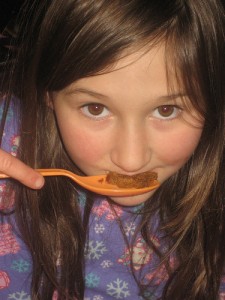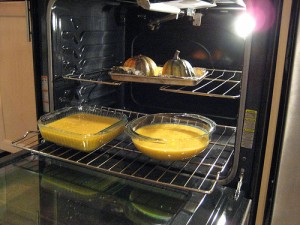As soon as I found out that cinnamon was high oxalate, I started experimenting with my pumpkin custard recipe to see if I could make a cinnamon-free version. My boys love pumpkin custard and my low sugar variation is perfect for breakfast or a snack. We needed to create a new low-oxalate custard recipe and fast!
I was pleasantly surprised at how easy it was. In fact, I’m somewhat happy I was forced into trying something new because I really love the raw ginger is this ginger pumpkin custard. My first try turned out to be the best, so here it is! We use the lower sugar variation for side dishes and the higher sugar variation with whipped cream for a dessert. You can also add more eggs for a higher protein version, which makes a great breakfast.
Ginger Pumpkin Custard
2 cups pumpkin puree (see note on how to bake a pumpkin)
3 eggs
3/4 cup cream, half and half or coconut milk*
1/4 – 1/2 cup honey
1 tablespoon raw ginger, minced or grated (I use a garlic press to mince the ginger)
1 teaspoon nutmeg
1 teaspoon vanilla extract (optional)
Dash salt
Preheat oven to 325 degrees. Put all the ingredients in bowl and stir until well mixed. Turn into a greased 8 x 8 baking dish or pie plate (see note on baking dishes). Bake for about 40-45 minutes until the center is set. Serve warm or cold (we like it cold). If serving as a desert (higher sugar version) you may want to add a dollop of whipped cream. If serving as breakfast or side dish (lower sugar version), you may want to add a dollop of plain yogurt or coconut cream.
Serves 8 (recipe easily doubles)
How to Bake a Pumpkin: Heat the oven to 350 degrees. Cut a pie pumpkin in half (use a sharp knife and make multiple cuts instead of sawing). Scrape out the gooey insides and save the seeds to make toasted pumpkin seeds (recipe upcoming). Lightly grease a cookie sheet and place the pumpkin flesh-side down. Bake until the pumpkin’s skin is lightly browned and the flesh is soft–about 45 – 60 minutes. Let the pumpkin cool. Scoop out the flesh and either puree in a blender or food processor, or mash with a potato masher (a fork can also work). One pie pumpkin usually yields about 3-5 cups of pumpkin puree, although some of the bigger, fleshier ones can yield more. You may also use this method to bake butternut squash or acorn squash although cooking times are less (30 minutes for acorn squash and 45 minutes for butternut squash).
A Note About Coconut Milk: This recipe works great with coconut cream or with any creamy variety of canned coconut milk, usually marketed for Asian or Caribbean cooking (I use my store’s brand, but Chaokoh is a good choice with zero oxalate content). Do not use the coconut milks that come in a carton and are marketed as non-dairy milk substitutes (usually are found next to the rice, soy or almond milks). These are too watery and have not been tested for oxalate content.
Update 6/12: I recently started using Natural Value coconut milk and am much happier with it than the Chaokoh. I originally used Chaokoh because it had tested at zero mg. oxalate, but I was unhappy with putting preservatives in my body (especially considering I probably have a leaky gut), so I started using my store’s brand although I knew the guar gum probably raised the oxalate content substantially. Natural Value coconut milk contains no preservatives and no guar gum – just pure coconut! It should be very low oxalate (possibly zero) and I feel confident recommending it as a preservative-free alternative to Chaokoh. It is currently the only coconut milk I am using and I am happy with the quality and the way it works in my recipes.
A Note About Baking Dishes: If you use a glass baking dish you must turn down the temperature in your oven by about 25 degrees and increase cooking time about ten minutes. Glass dishes have a tendency to burn the edges of delicate egg dishes. Ceramic casserole dishes are usually a better choice. You also want to make sure that the pumpkin mix is between 2 and 4 inches deep in your dish of choice. If you double the recipe and then use a small casserole dish (so the mixture is 4-6 inches deep in the dish) the sides will burn before the center is finished cooking. I usually double my recipe and use a large ceramic pie plate (12 inch diameter). It took me about three trials before I found that this was the best dish in my house for custards and egg casseroles. You may have to experiment, too. Also note that honey sometimes causes excessive browning on the edges of a custard. If you are using the sweeter version you may want to turn your oven down and cook the custard a little longer.
Low Oxalate Info: Nutmeg (9.4 mg./tablespoon) and raw ginger (6.3 mg./tablespoon) are medium oxalate ingredients. All other ingredients are low or very low oxalate. Ginger Pumpkin Custard has about 3.3 mg. oxalate per serving (based on 8 servings made with canned pumpkin). The oxalate content may be lower when using fresh pumpkin.
Substitutions: You may substitute acorn squash or butternut squash for the pumpkin (oxalate content will increase by about 1 mg. per serving when using butternut squash). Butternut squash is particularly yummy! You may also use canned pumpkin if you wish. Please note that canned pumpkin often has less moisture than fresh pumpkin, so you may have to add a little more half and half or coconut milk (up to 1/4 cup). I suggest you try the recipe first and see how it works before adding moisture to canned pumpkin.
You may increase the ginger up to 2 tablespoons. I love this, although the boys do not. An additional tablespoon of ginger adds about 0.8 mg. oxalate per serving. This version really deserves the name ginger pumpkin custard!
You may replace the honey with maple syrup or with liquid stevia (use about a half teaspoon of liquid stevia) with little change in oxalate content. If you use liquid stevia, increase the half and half by a few tablespoons to make up for the decrease in moisture when leaving the honey out. I like the combination of 1/8 cup honey with half a dropper of liquid stevia for a lightly-sweetened side dish.
You may add up to two more eggs for a higher protein version of the custard. If you add more eggs, also add more half and half or coconut cream (about 1/8 cup more per egg). You may also want to add a little more ginger and nutmeg as the higher egg version tends to be a little bland. Adding two eggs, 1/4 cup coconut milk and a half tablespoon of ginger only increases the oxalate content of the entire custard by 3.2 mg. oxalate.
Other Diets: Ginger Pumpkin Custard may be appropriate for gluten-free, dairy-free, vegetarian, Primal, Paleo, moderate carb, GAPs, and SCD diets with appropriate ingredient choices.
Photo credits go to mia3mom for Friday Photo: Orange and to sundaykofax for IMG-0698.


{ 6 comments… read them below or add one }